Recently, I was asked to help cook for a young girl who is on a low microbial neutropenic diet. I had never worked with this diet before, but after some research figured out it’s not as complicated as it sounds. A low microbial neutropenic diet is essentially a diet that ensures food is safe. Safe means free of microbes such as bacteria, viruses, yeast and molds. To be honest, we all should be preparing our meals so they’re safe.
People with healthy immune systems can handle food that has some microbes. Unfortunately, people with weak immune systems cannot. This includes cancer patients who have a low white blood cell count (leukopenia) after undergoing chemotherapy, radiation therapy or a bone marrow or stem cell transplant. People with leukopenia are at a high risk of infection, which is why a doctor might prescribe a low microbial neutropenic diet.
During food preparation, there are several stages where it is important to keep food safe:
- Purchasing ingredients
- Transporting ingredients
- Storing ingredients
- Cleaning the workspace
- Preparing ingredients
- Cooking ingredients
- Storing cooked food
1. Purchasing Safe Ingredients
- Make sure all items that should be cold stay cold, e.g., dairy products
- Buy whole fruits and vegetables (not pre-cut) and make sure they are free of bruises, cuts or mold
- Make sure all bottled/packaged items are properly sealed and have not reached their expiration date
- Buy cheese that is commercially packaged (not cheeses that are cut and rewrapped)
- Do not buy from bulk bins, salad bars, deli counters
- Keep raw meat/seafood separate (and wrapped properly) from raw produce
- Buy only pasteurized products, e.g., milk, cheese, juices
- Do not buy smoked seafood, e.g., lox, smoked salmon
2. Transporting Ingredients Safely
- Go directly home after purchasing ingredients
- If it is hot out, bring a cooler/insulated bag with frozen ice packs
3. Storing Ingredients Safely
- Store ingredients in refrigerator or freezer as soon as you get home
- Store items on the inside shelves of the refrigerator, not the door
4. Cleaning the Workspace
- Designate a space in your kitchen for meal preparation
- Use anti-bacterial cleaning spray and paper towels or a clean cloth to wipe the surface down
- Use anti-bacterial cleaning spray and paper towels or a clean cloth to clean cutting boards (use plastic cutting board, not wood, and have one cutting board designated for produce and a separate cutting board for raw meats/fish)
5. Preparing Ingredients Safely
- Wash your hands throughly with soap and water before preparing food and after preparing raw meat/seafood (I like to use disposable food service gloves)
- Wash produce thoroughly even if you plan on peeling it or cutting it
6. Cooking Ingredient Safely
- Make sure all foods are completely cooked, including raw fruits and vegetables. Eggs should be hard boiled (unless you use pasteurized eggs, which can be scrambled soft)
- Well washed thick-skinned fruits can be peeled and eaten, e.g., bananas, avocados, mangos and melons
- Use a food thermometer to make sure the internal temperature of food reaches the safe minimum temperature -1)
7. Storing Cooked Food Safely
- Refrigerate food as soon as it is slightly cooled
- Freeze any food you will not consume within a day or two (I froze individual portions of meatballs, meatloaf and soup in quart-size freezer bags on a baking sheet; this makes for more efficient storage in the freezer. Be sure to label the contents and date)
- Reheat leftovers to an internal temperature of at least 165 degrees for at least 15 seconds -1)
- Do not eat food that has been already been reheated once
Are you or do you know someone on a low microbial neutropenic diet? If so, please share your experience and tips in the comments section.
1) Memorial Sloan Kettering Cancer Center Low-Microbial Diet
Note: These guidelines were gathered from Memorial Sloan Kettering Cancer Center’s information and is based on my personal experience cooking for someone on a low microbial neutropenic diet. Be sure to consult with your physician/oncologist and nutritionist if you are advised to be on this diet.
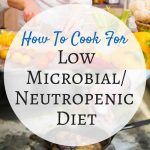
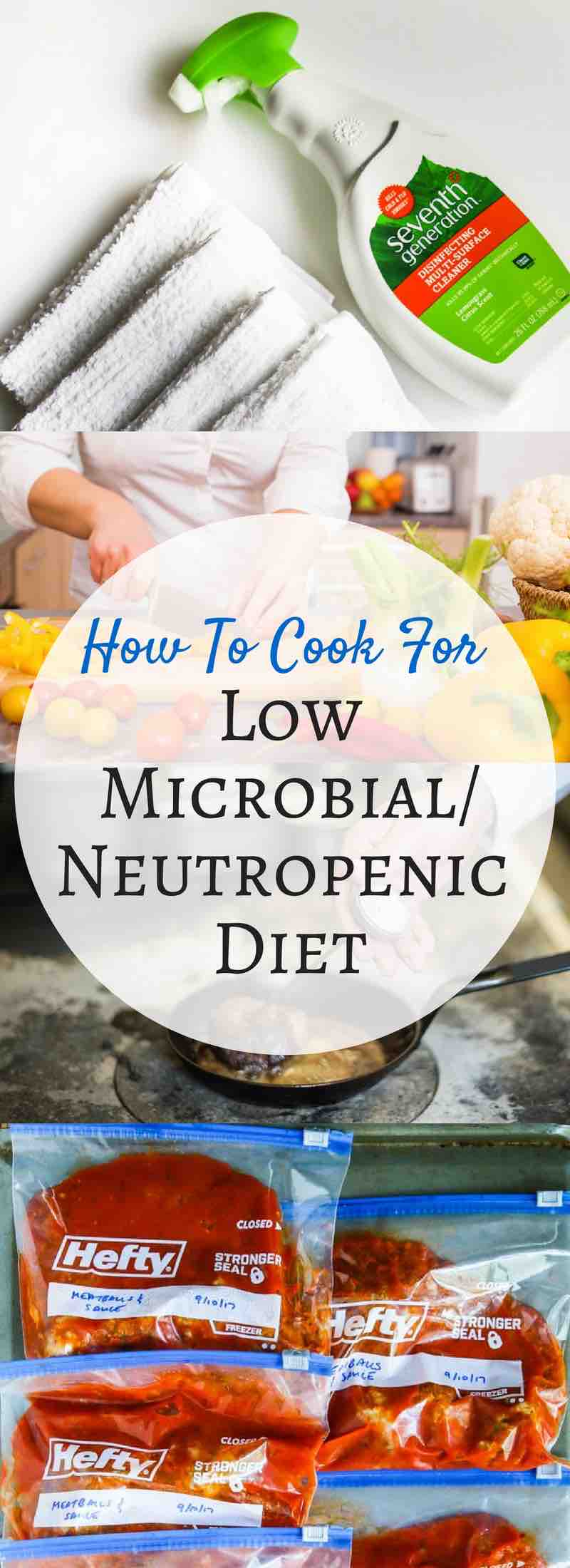
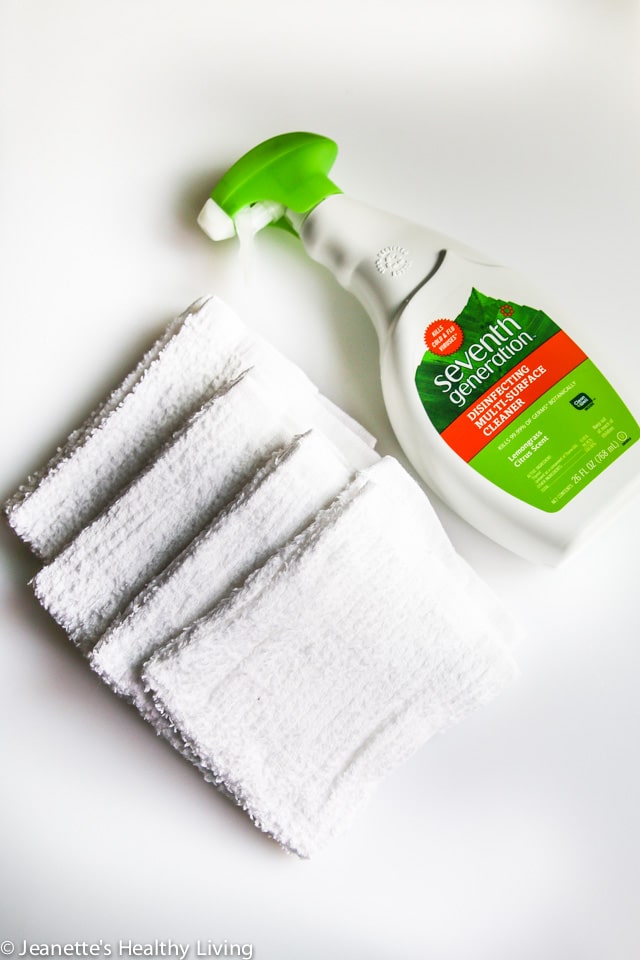
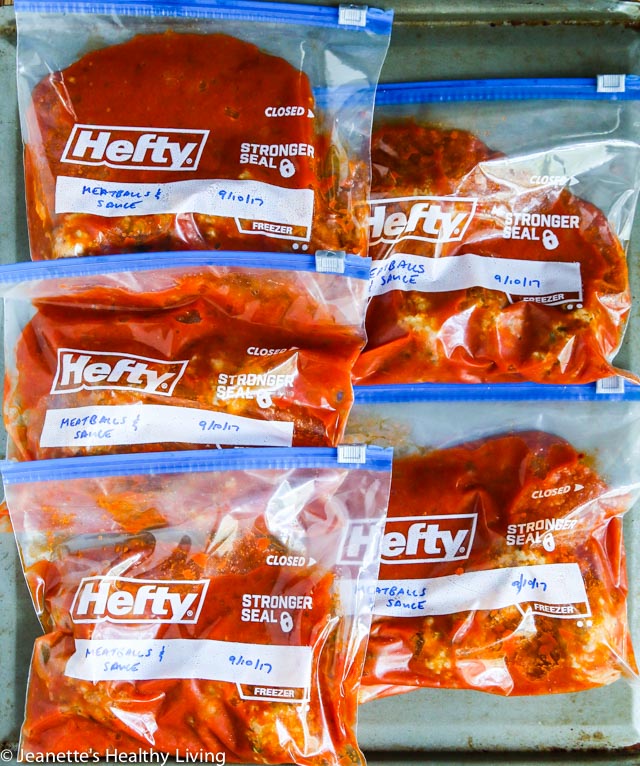

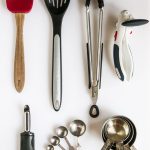
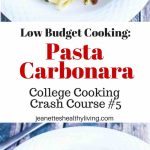

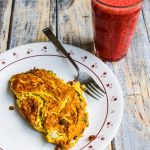



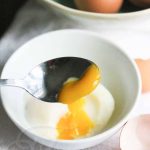
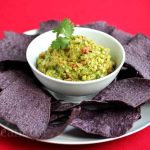
Yes I’m on this diet. I’ve had a stem cell transplant. Trying to find quick and easy prep meals.
Best wishes Erma – let me know if I can help come up with meal ideas
my husband is on this diet and when you say to wash the fruits and veggies what do you wash them with? Dish soap, hand soap, a special food soap im just not sure.
Hi Bianca, I did not use any soap to wash the fruits and veggies – just scrubbed really well with hot water. I also peeled/removed skin from all fruits and vegetables.
Hi Jeannette, my six year old has been diagnosed with neutropenia from the influenza virus. Do you have a meal menu that I can follow to help me prepare his meals? I appreciate any advise you can give.
The main thing I learned about the neutropenic diet is that ingredients need to be cleaned, cooked and stored properly. If you follow the tips in this post, you can prepare almost any of your son’s favorite meals – you just need to be especially careful that the food is handled properly.
Jeanette, I cannot thank you enough for writing and publishing this. I’m writing this with tears of joy rolling down my face that FINALLY, some sort of advice/tool I can use to help take care of my cousin. Ashlee now 29, was Diagnosed almost a year ago, days after her sons first birthday, with stage four Hodgkin’s lymphoma , at 28 years old. Fast forward to today, she just got out of the hospital 3 days ago, from her cell transplant. . I’m preparing my trip as I’m in Phoenix to go see her at home in Denver on February 5th( this Wednesday). I’ve been online for almost 2 days, looking for anything stem cell diet related. NOTHING, it’s so frustrating, and sad. These poor patients, leave the hospital without a immune system, so incredibly sick, weak, mentally and physically depleted, with limited resources. It’s like putting a newborn baby out on the streets, and saying good luck, you got this. I thought surly between Pinterest/Instagram/Google, etc. I’d did something, weekly meal plans, nothing. I understand stem cell is still fairly new, but with 176,200 new cases of blood cancers diagnosed in 2019, it shouldn’t be this hard, to feed our loved safely, that have already and continue to go though the hardest time in their life’s.
Kelly, best wishes for your cousin Ashlee. She is so fortunate to have you trying to help her.